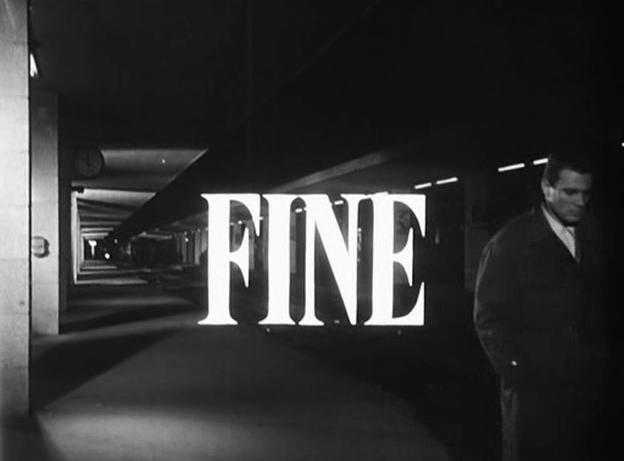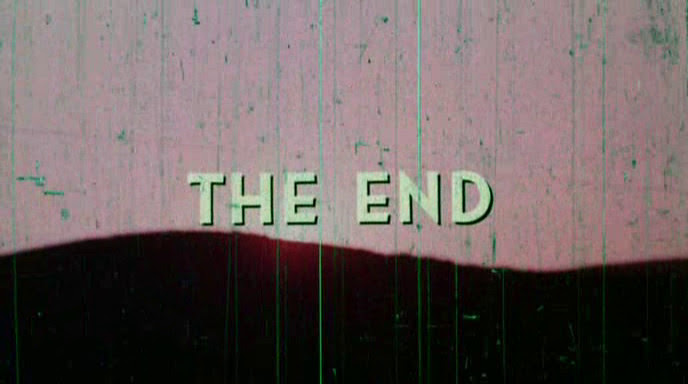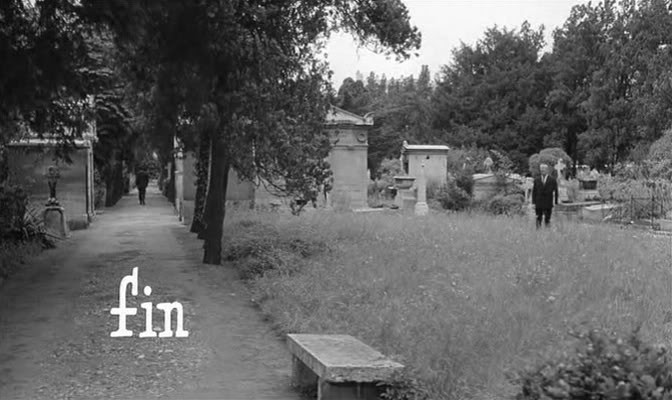.

Blood on the Moon (1948): photo by hytam2, 1 April 2014
My prime of youth is but a froste of cares:
My feaste of joy, is but a dishe of payne:
My cropp of corne, is but a field of tares:
And all my good is but vaine hope of gaine:
The daye is gone, and yet I sawe no sonn:
And nowe I live, and nowe my life is donn.
The springe is paste, and yet it hath not sprong,
The fruite is deade, and yet the leaves are greene
My youth is gone, and yet I am but yonge
I sawe the woorld, and yet I was not seene
My threed is cutt, and yet it is not sponn
And nowe I lyve, and nowe my life is donn.
I saught my death, and founde it in my womb,
I lookt for life, and sawe it was a shade.
I trode the earth, and knewe it was my Tombe
And nowe I die, and nowe I am but made
The glasse is full, and nowe the glass is rune
And nowe I live, and nowe my life is donn

Véronique et son Cancre (1958): photo by Aka Vetala (omoplata 1), 8 February 2014

Le Amiche (1955): photo by Aka Vetala (omoplata 1), 4 February 2014

Mahanagar (1963): photo by Aka Vetala (omoplata 1), 10 September 2013

Mercy (1970): photo by Aka Vetala (omoplata 1), 22 October 2013

Un Nommé La Rocca (1961): photo by Aka Vetala (omoplata 1), 23 November 2013

Gideon of Scotland Yard (1958): photo by Aka Vetala (omoplata 1), 20 April 2014

The Horror of It All (1964): photo by Aka Vetala (omoplata 1), 13 April 2014

Chikaketsu renzoko reipu (1985): photo by Aka Vetala (omoplata 1), 21 October 2013

Warning Shot (1966): photo by Leo Garcia (LenhillAdvanced), 10 January 2014

El Pico (1983): photo by Aka Vetala (omoplata 1), 1 February 2014

The Sandpiper (1965): photo by Leo Garcia (LenhillAdvanced), 28 January 2014

Dentist on the Job (1961): photo by hytam2, 13 March 2014



12 comments:
The unfortunate Chidiock Tichborne came from a devout Catholic family. Tichborne and his father were more than once subjected to investigation by agents of Queen Elizabeth, and one one occasion charged with possession and use of otlawed "popish" relics. In 1586 he attended meetings of a group of conspirators in an ill-conceived plot to assassinate the Queen and replace her with the Catholic Mary Queen of Scots. The plot was discovered by a double agent in the employ of Elizabeth's spymaster Francis Walsingham. Immobilized by a leg injury and unable to flee, Tichborne was stranded in London, arrested, locked up in the Tower, charged with treason, tried, and, after being found guilty, hanged, taken down while still fully conscious, had his "privities cut off", was "bowelled alive and seeing", then quartered. The poem was sent by the condemned man to his wife, Agnes, on the day before the gruesome execution.
Tichborne's Elegy, resurrected
On the other hand, this is Marika’s elegy in the Greek film, “Rembetiko”.
https://www.youtube.com/watch?v=xo75hAarmEA
Vassilis, a beautiful film, that -- and yes, definitely a far better send-off than poor Tichborne, in his several bloody pieces, got.
Successful or not, regicide is something the royals put down with the utmost ferocity, not to say depravity. And the slaughter turning on questions of religion, as it does here, has a unique savagery. But what composure in Tichborne, to write those summary lines about a life coming to a close. He must have known what would happen. Had he won out, would he have been like his executioners?
Somehow I suspect not. That sort of exquisite brutality seems to require the foundation of an absolute authoritarian power to make it work. The Tudors had by then had at least a century of practise in such businesses, before Elizabeth, with the essential help of Walsingham, refined them into a dark art.
On the other hand, as history shows, savage persecution, originating in programmatic intolerance, and exercised as institutional policy, tends to have a kind of rebound effect, over time, of increasing rather than diminishing the resolve of the victims. No one understood this better than the last of the Tudor monarchs. After the horror show of eviscerations, hangings and drawings and quarterings dealt out to the "conspirators" in St Giles' Fields, there seems to have been a reconsideration of policy.
Tichborne's punishment in particular was extreme -- though, again, merely after the manner of the rough justice not uncommonly dispensed to those of his contraband faith. Still news of Tichborne's grotesque and cruelly protracted death and, worse, of the rumours it had incited, evidently affected the Queen, who "forbade the recurrence" of this particularly gruesome mode of execution.
The poem was first printed in 1586, shortly after the poet's death. It quietly made a martyr of its author.
Predictably, a Royalist poet was assigned to hammer out a response. This was done by one "TK", now speculated to be the Elizabethan playwright Thomas Kyd:
Hendecasyllabon TK in Cygneam Cantionem Chidiochi Tychborne
Thy prime of youth is frozen with thy faults,
Thy feast of joy is finisht with thy fall:
Thy crop of corne is tares availing naughts,
Thy good God knowes, thy hope, thy hap and all.
Short were thy daies, and shadowed was thy sun,
T'obscure thy light unluckelie begun.
Time trieth trueth, & trueth hath treason tript,
Thy faith bare fruit as thou hadst faithless beene:
Thy ill spent youth thine after yeares hath nipt,
And God that saw thee hath preserved our Queen,
Her thred still holds, thine perisht though unspun,
And she shall live when traitors lives are done.
Thou soughtest thy death, and found it in desert,
Thou look'dst for life, yet lewdlie forc'd it fade:
Thou trodst the earth, and now in earth thou art,
As men may wish thou never hadst beene made.
Thy glorie and thy glasse are timeles runne,
And this, O Tychborne, hath thy treason done.
No one ever claimed truthfulness as an invariable ingredient in all that is presented under the aegis of poetry. Time-serving, cliché-parrotng and pursuit of personal advantage have trumped it 99% of the time.
And as to poor Tichborne's state of mind at the time of composition of his elegy for himself -- which surely was during his period of incarceration in the Tower, awaiting an execution whose exact parameters were hopefully unclear to him, but may or may not have actually been on the eve of the hideous event -- we can but guess.
There is Samuel Johnson's remark, quoted by Boswell, "Depend upon it, sir, when a man knows he is to be hanged in a fortnight, it concentrates his mind wonderfully."
By the by, for those interested in "the facts of the case": the conspiracy was known as "The Babington Plot", and Chidiock Tichborne was never more than a bit player, sitting in with others, as pictured in Charles Nicholl's enthralling The Reckoning: The Murder of Christopher Marlowe, at sessions of "wild talk -- heads filled with wine, with dreams of Catholic rebellion, with an overheated, cultish devotion to the imprisoned Queen Mary -- but what shape it had in terms of real action was largely provided by the government itself, whose agents infiltrated the conspiracy not so much to destroy it, as to encourage it."
The principal conspirators were Anthony Babington, who, it seems, had been inspired, as a page-boy in the Earl of Shrewsbury's household, by a passing glimpse of Mary; a wandering outlaw priest named John Ballard; and one John Savage, who, at Rheims, had been said to have sworn a solemn oath to kill the English queen.
The object of Walsingham's strategy was entrapment of supporters of Mary.
"In the words of a priest named Davis, who was with Babington on the night before his capture, the plot was a 'tragedy', in which 'the chief actor and contriver' was Sir Francis Walsingham. This is a partisan view, but on the evidence it is true enough. The Babington affair was classic piece of Walsingham 'projection': a piece of political theatre, conjured up for reasons of cynical expediency."
There's a shocking brevity to the poem, each line a wounding.
There's something powerful and unsettling in the contrast between the horrendous longeurs of Tichborne's dying and these moments of mute finality from various end-credits. Truly *stills* - enigmatic (meaning/ implication remain open and 'alive')and non-negotiable at one and the same time.
Brilliant poem, and post, and supplementary notes. Tichborne's is a diamond produced under unimaginable pressure, it still leaves a sense of shock in the room. But TK's poem is surprisingly impressive too. One could make quite a disturbing little anthology of Elizabethan Celebrations of "Strong Government"; it could include this gem alongside Spenser's Talus and Shakespeare's burning of La Pucelle.
If as I've said the exact moment of its composition during his stay in the Tower (from his arrest on 14 August to his execution on 20 September) is unknown, it is certain that Tichborne's poem was included in the letter to his wife dated 19 September.
Walsingham, as Charles Nicholl persuasively argues, had deliberately kept the developing plot "in play", allowing the conspirators to further entrap themselves for some weeks (with his agent Robert Poley embedded in their midst and reporting back to him even while urging the plot on), until he came to fear that the central figure, Anthony Babington, might be about to slip away. The net was then drawn closed. One of the ringleaders, John Ballard was arrested on 4 August. The other conspirators scattered. Warrants were issued, watches set on the main roads out of London. After a few days in hiding, Tichborne, gamey leg and all, attempted with two others to travel south. They were quickly intercepted. Babington and a couple of others headed north, and joined up in the wilds of St John's Wood, where they lived rough for eight days before being captured after seeking food and refuge with a Catholic family near Harrow. When seized, they were hid in a barn, wearing coarse smocks and with hair shaved off, after the manner of itinerant labourers. Their return, under close guard, to London, was greeted by celebratory ringing of church bells, in thanksgiving for the Queen's supposed deliverance.
Some of those involved in the conspiracy had slipped away to France. The captive plotters, already very much the worse for the trials of their unsuccessful escape attempts, were now subjected to "interrogation" (which included searches and questioning of wives, mothers, servants, messengers, bystanders and friends). One of the men thus "questioned", John Ballard, had been tortured so badly he could not stand, and had to be brought into court in a chair.
The court of treason convened on 13 September. Two days later the list of defendants was extended beyond the original seven to include another seven, charged as co-conspirators or accessories. The latter group included one of two brothers charged with harbouring the fugitives. A second brother was said to have "strangled himself" while in custody awaiting trial.
The executions were conducted over two days, at a gallows constructed for the occasion, on St Giles's Fields. The doomed men were dragged through the streets on sleds en route to the show, with street rabble shouting well-oiled calls of derision and exhortations to repent.
Chidiock Tichboune was fourth of the seven men to be executed on the first day. The course of the executions was approximately the same from man to man, with some nuances demanded by special circumstance. A cart was drawn up, a man hung for some moments, just long enough to swing a few times, before the cart was driven away. The men, still alive were then cut down for butchering -- though the largest of them, the intensely committed John Savage, had broken the rope on his first swing, and had to be eviscerated without even the convincing theatrical appearance of being hung.
The executions on the next day were comparatively merciful. Those hung were left to dangle till "quite dead" -- this as a magnanimous gesture of humanity on the part of the Queen.
An official explanation of the change in execution methods was issued:
"The Queen, being informed of the severity used in the executions the day before, and detesting such cruelty, gave express orders that these should be used more favourably."
This is beautifully composed, all of it (poetry, images, comments) and I've learned a lot from it. I would like to think your "Somehow I suspect not" comment is accurate, but obviously we'll never know. It's very difficult, for a number of reasons, to imagine oneself in Chidiock Tichborne's place. Curtis
Post a Comment